Did you know that gated content could be the ultimate key to getting more email subscribers and customers on your website?
When you require sign-up or sign-in to see some of your best content, you create a fantastic incentive for your website visitors. A gated content marketing strategy helps you boost your lead generation efforts and grow your email list.
In fact, our client Photowebo increased their conversions 3806% by using gated content!
Do you want to learn how to get results like this?
In this detailed guide, I’ll walk you through the ins and outs of content gating, so you can effectively engage your audience and generate high-quality leads.
Quick links:
- What Is Gated Content?
- Gated vs. Ungated Content
- When Should You Gate Content?
- Gated Content Examples
- Gated Content Best Practices
- How To Create Gated Content
- Which Content Gating Tool Should You Use?
What Is Gated Content?
Gated content is online material, such as articles, videos, infographics, or downloadable resources, that you can only access after taking a specific action.
Usually, this action involves the user sharing information, like their email address or name. It’s basically an exchange: users provide some details and get access to premium content in return.
As we’ll discuss later, gating content has pros and cons. But when done right, it can
- make your content more appealing
- help you to engage with your target audience
- result in better leads
OptinMonster is the most robust lead-generation software on the market, and our content-locking feature lets you implement a gated content strategy in minutes. Our clients have seen excellent results from content gating, including one website that got 11,000 new subscribers monthly with a simple content upgrade.
Case Study See how one digital agency used gated content to boost conversion rates by 62% and 2x their email list.
For more details, keep reading!
Gated vs. Ungated Content
Now that you know the basic meaning of gated content, let’s talk about the difference between gated and ungated content. Picture two paths in a garden:
- Gated Content: This path is like a VIP entrance. When you go down the gated path, you agree to provide some personal information, like your email or zip code. In return, you can access more in-depth, valuable, or exclusive content. Think of it as a way for websites to get to know you better and offer you something special in return.
- Ungated Content: Conversely, the ungated path is like a stroll in the park. You can enjoy the content without sharing any personal information. It’s a lot like watching a movie trailer. You get a taste of what’s inside but don’t have to give anything in return.
In essence, gated content is a secret club where you exchange a small piece of information to access premium content. In contrast, ungated content is freely available for anyone to enjoy without any strings attached.
When Should You Gate Content?
Let’s explore when you should consider gating your content.
1) When It’s Extra Special
Like you save your favorite treats for special occasions, consider gating your most exceptional, high-content. Do you have a post or guide packed with insights, solutions, or secrets? One that has information your audience can’t easily find elsewhere? It might be a good candidate for gating.
2) For In-Depth Guides and Resources
Long-form pieces are also excellent candidates for gated content. Gating content like comprehensive guides, ebooks, or webinars that dive deep into a topic can be a great idea. People are more willing to share their info for valuable, in-depth resources. Often, these are offered as downloadable lead magnets.
3) For Exclusive Events and Experiences
You can also think of content gating as a lot like handing out VIP passes to an exclusive party. Locking content can create excitement and exclusivity if you’re offering something unique, like a live webinar with an industry expert or early access to a product launch.
4) For Valuable Tools and Templates
Imagine you’re giving someone a toolbox filled with handy gadgets. One smart gated content strategy is to offer practical tools, templates, or checklists. These should be resources that your target audience can use to solve real problems. People are often willing to trade information for tools that make their lives easier.
5) When Building Your Email List Matters
Any great email marketing strategy starts with a strong list of highly-interested leads. Just like you’d collect keys to open different doors, gating content can help you build a list of interested people. If growing your email list or capturing leads is a priority, gating certain content pieces can be an effective way to achieve that.
6) For Advanced Learning
Imagine you’re sharing advanced secrets with those who are ready to learn. You can deliver true value to your users by gating content that caters to a more experienced or specialized audience. The leads you gain with this strategy are likely to become some of your most engaged users and customers.
7) When You’re Testing Waters
Think of gating content as trying a new recipe. You want to see if people like what you’re making before making a big batch. If you’re experimenting with new ideas, products, or offerings, gating the content can help gauge interest and gather feedback.
8) Balancing Gated and Free Content
Imagine you have a buffet with some special dishes behind the counter. If customers have to ask for every dish that they’re interested in, they’ll likely just go somewhere else.
That’s why it’s essential to strike a balance between gated and free content. Gating everything might turn people away, but offering a mix of both can help you provide value to different types of audiences.
You must make sure that you have a wide variety of high-quality content that website visitors can read for free. Once they trust your expertise, they’ll be more likely to sign up when they come across locked content.
Ultimately, the decision to gate content boils down to the value you’re providing, as well as your goals. Just like protecting precious items, gating content adds a layer of exclusivity, making your audience feel like they’re part of something special.
Understanding when and why to use gated content can create a strategy that enhances engagement, builds relationships, and opens doors to exciting opportunities.
Gated Content Examples
Here are some real-life examples of gated content that companies and organizations have used to engage their audiences and generate leads:
1) HubSpot’s Marketing Resources

HubSpot, a leading inbound marketing platform, offers a variety of gated content resources such as ebooks, templates, and guides. Users can access these valuable materials by providing their contact information, which helps HubSpot build their email list and nurture leads.
2) Neil Patel’s Advanced Marketing Guides
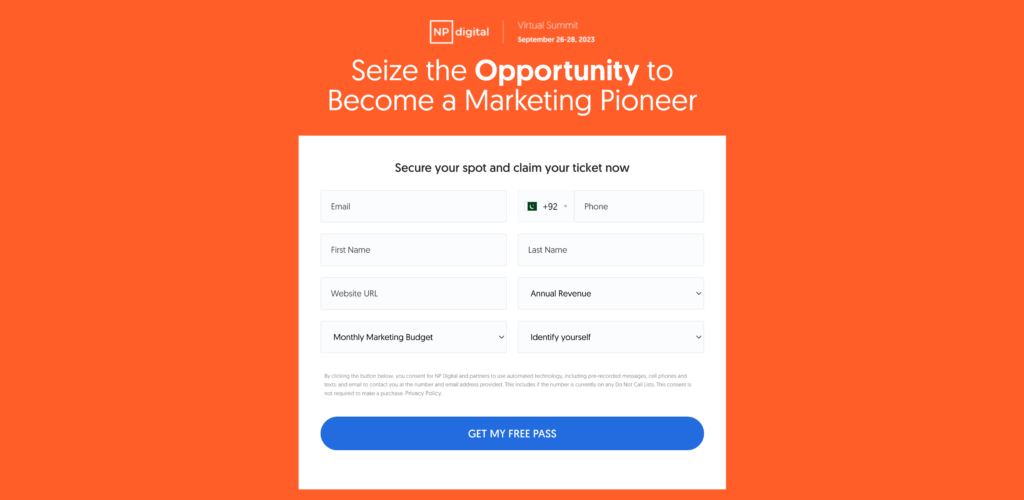
A prominent digital marketing expert, Neil Patel, provides in-depth guides and courses on topics like SEO, content marketing, and social media. Access to these advanced guides often requires users to opt in with their email addresses and other information.
Due to the advanced nature of his content, Patel asks for a lot more information than you’d usually want to require. Neil Patel also has established authority in his field, which makes it more likely for users to be willing to fill out so many fields. With the information he gains from this form, he’ll have the data he needs to segment his leads and personalize his marketing strategy.
However, for most websites, your initial optin forms should just ask for an email address and first name.
3) Moz’s Whitepapers and Webinars
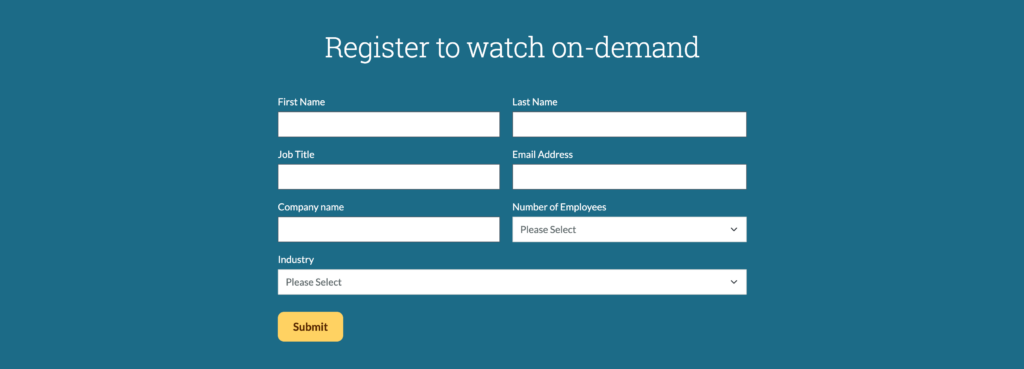
Moz, a well-known SEO software company, offers whitepapers and webinars on topics related to search engine optimization. Users can access these resources by filling out a form, allowing Moz to capture leads and provide valuable insights to their audience.
4) Salesforce’s Reports and Surveys
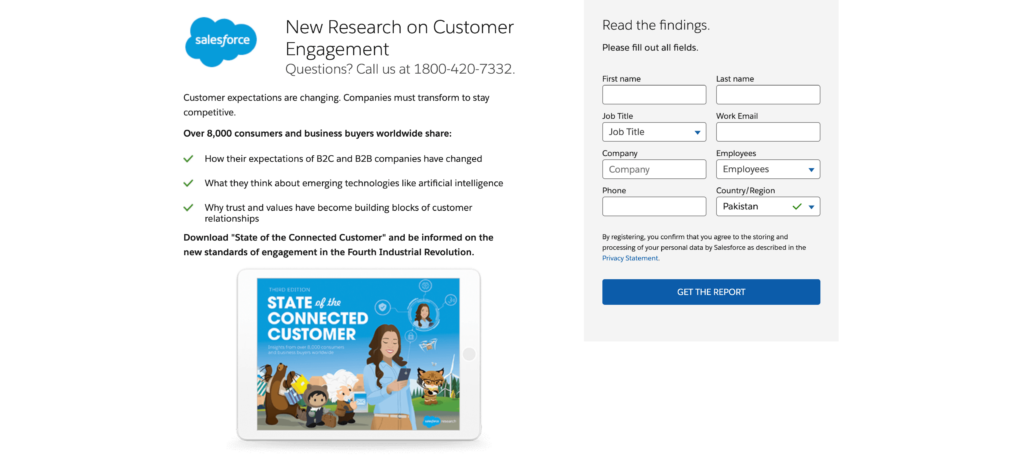
Salesforce, a leading customer relationship management (CRM) platform, publishes industry reports and surveys that provide valuable insights into trends and best practices. These reports are often gated, requiring users to provide their information before accessing the data.
5) DigitalMarketer’s Training Videos

DigitalMarketer, a platform focused on digital marketing education, offers training videos on various marketing strategies. Users may need to sign up and provide their email addresses to watch these videos.
6) The New York Times (News Publishing)

The New York Times offers non-subscribers a limited number of free articles each month while gating the rest of their premium content behind a paywall for subscribers.
7) Medium (Content Publishing Platform)
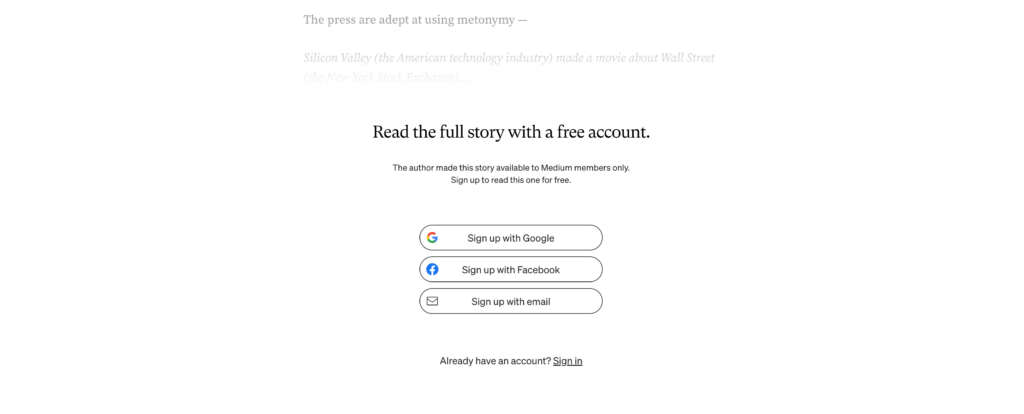
Medium offers a membership program where subscribers can access premium articles, curated content, and exclusive features created by a community of writers. As a major publication, they’re able to offer account creation through Google, Facebook, or manually with an email address.
The examples above illustrate how companies leverage gated content to offer valuable resources, insights, and education in exchange for user information.
Gated Content Best Practices
Now that we’ve thoroughly examined content gating, let’s look at some best practices.
1) Know Your Audience Inside Out
Before you create gated content, gaining a deep understanding of your target audience is crucial. It would be best if you answered the following questions:
- Who are they?
- What challenges do they face?
- What information are they hungry for?
Tailor your gated content to address their needs, pain points, and aspirations, ensuring it offers real value and resonates with their interest along the buyer’s journey.
2) Choose the Right Format
Gated content comes in various shapes and sizes. From ebooks and webinars to templates and case studies. Select the format that aligns best with your audience’s preferences and the nature of the information you’re sharing.
A well-chosen format enhances engagement and encourages users to provide their information willingly.
Bonus content: What is a Lead Magnet? Proven Lead Magnet Ideas and Examples
3) Craft Irresistible Headlines and CTA
A compelling headline and call to action button are your golden ticket to capturing interest in the digital age of short attention spans. Craft headlines that promise a clear benefit or solution, sparking curiosity as we move along the customer’s journey.
A well-crafted headline is the first step toward convincing users that your gated content is worth their time and information.
Bonus content: 130+ Proven Opt-in Headline Ideas to Get More Email Subscribers (Cheat Sheet)
4) Deliver Value Beyond Expectations
Gated content should surpass your audience’s expectations. Offer insights, knowledge, or solutions they can’t easily find elsewhere. Strive to provide actionable takeaways that empower your audience to apply what they’ve learned in their own endeavors.
5) Design User-Friendly Landing Pages
A seamless user experience is essential. Design landing pages that are clean and intuitive, guiding users through accessing your gated content. Keep forms concise, asking for only the necessary information, and assure users of the value they’ll receive in return.
Bonus content: Expert Tips for Writing Landing Page Copy That Converts & Anatomy of the Perfect Optin Landing Page (Tips & Best Practices)
6) Promote Strategically
Gated content is a treasure waiting to be discovered. Promote it across your marketing channels – from social media and email campaigns to your website and partnerships. Leverage teasers, snippets, and compelling visuals to create anticipation and drive interest.
7) Leverage Social Proof
Incorporate social proof, such as testimonials and user reviews, to boost credibility and increase conversions. When seeing others benefit from your gated content, people are more likely to provide information.
8) Decide How Visitors Will Access the Content
Knowing how you’ll give new subscribers access to the content you’ve gated is important. Some of the options include:
- Unlock on-page content immediately. This is easy to do with the instructions we’re about to share for content-locking campaigns.
- Sending the content by email, which I always recommend for downloadable content.
- Providing an immediate download link.
- Opening the content in a new window or redirecting subscribers to a page where they can access the content.
You can use any of these options in any OptinMonster campaign by customizing the success view.
The next section will show you how to gate content with OptinMonster.
How To Create Gated Content
Now, I’ll show you how to gate content by creating an inline form campaign for a particular page with OptinMonster. This type of campaign locks access to a particular blog post or page. Users must then sign up for your email list to access your content.
This tutorial assumes that you’ve already installed OptinMonster on your WordPress site or any other type of site. You’ll also need to integrate your email marketing software.
Step 1: Create Your Content Gating Campaign
First, click Create New Campaign from your OptinMonster dashboard.

You’ll asked whether you want to use one of OptinMonster’s Playbooks or Templates, or if you want to design your own campaign from scratch using our Canvas designer.
For our purposes, we suggest choosing Template:
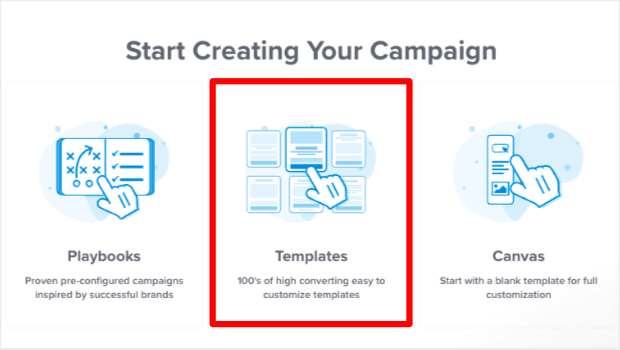
Next, you’ll need to choose a campaign type.
OptinMonster offers different campaign types, including:
- Lightbox Popup
- Floating bar
- Fullscreen
- Slide-in
- Inline
We’ll need to select an Inline Campaign to create a content lock campaign and choose a template.
OptinMonster offers 65+ templates, and all work beautifully across all devices.
In the search bar, type in “gated content” to easily find the Unlock Gated Content template.

Once you click Use Template, you’ll be prompted to name your campaign and choose the website you want to display it on.
Step 2: Activate the Content Lock
First, we’ll activate the content lock feature.
Choose the Display Rules tab at the top of your campaign design screen.
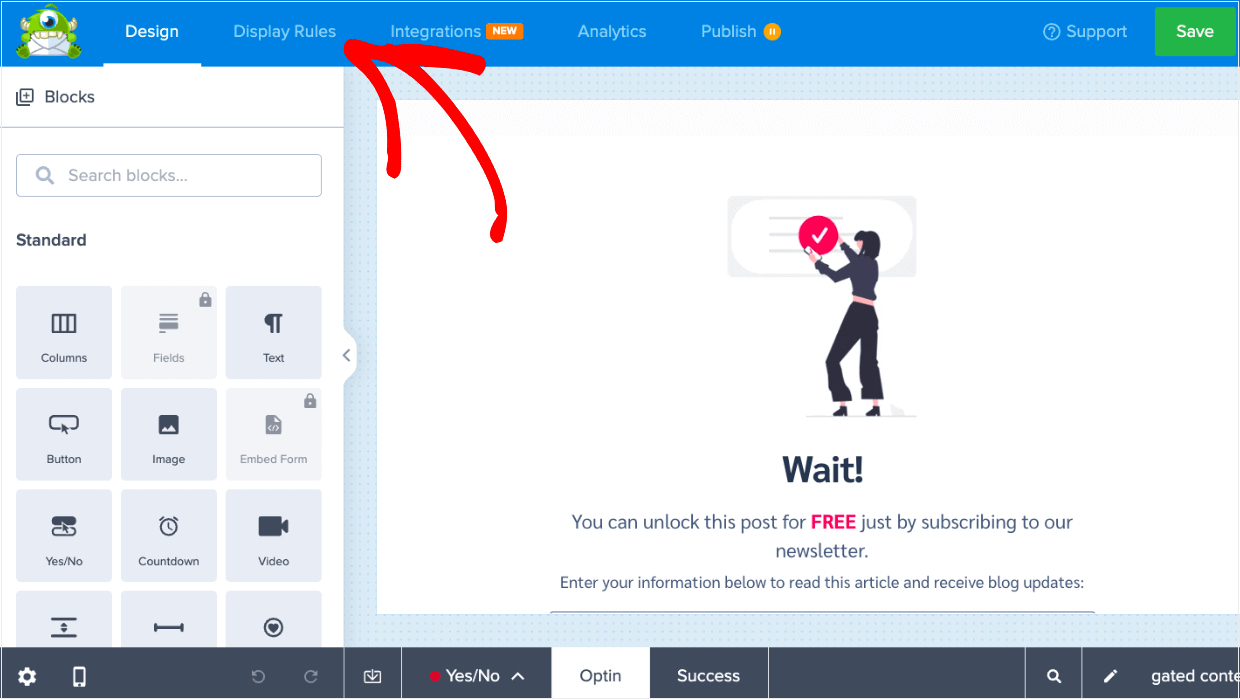
Next, select the Actions tab at the bottom of the screen and click the Enable Content Locking toggle so it turns blue. In the dropdown menu, you’ll be able to choose whether you want to blur your locked content or remove it completely.
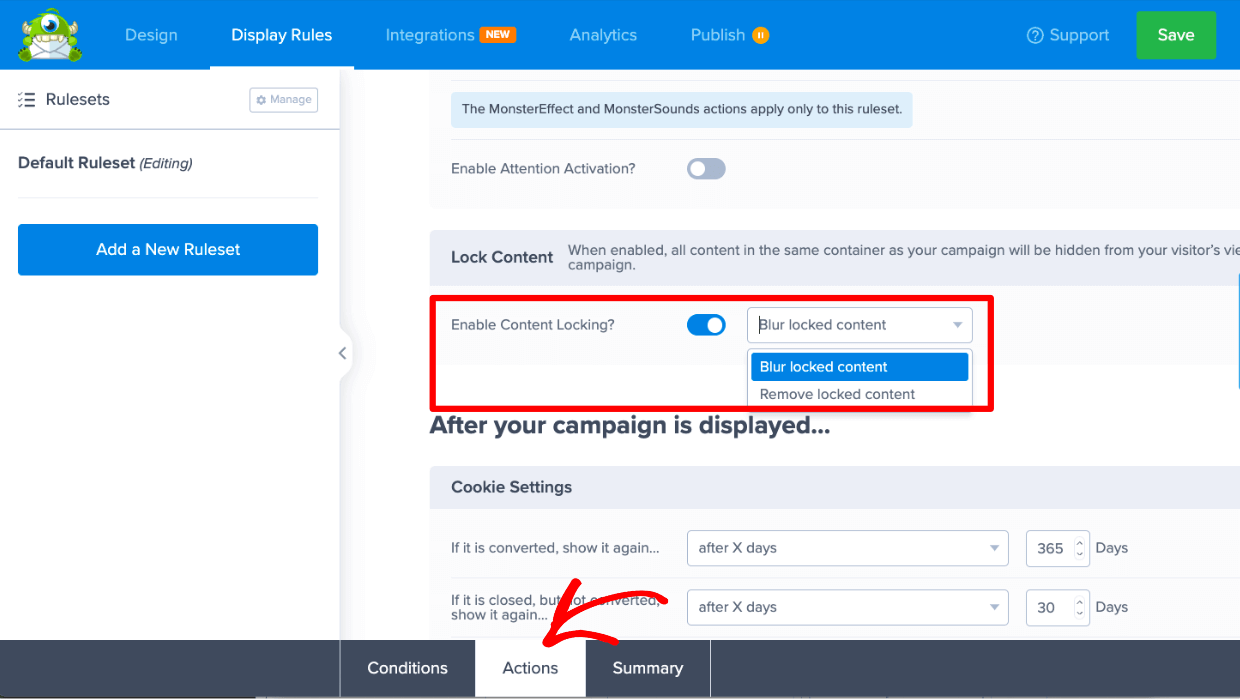
Now, we’re ready to customize our content lock campaign.
Step 3: Design Your Content Lock Campaign
Changing anything about your content lock campaign form is easy in the OptinMonster drag-and-drop builder and editor. Go back to the Design tab to return to the editor.
All you need to do is click on any part of the campaign to change it.
To edit the text, click on it or highlight the text. This will bring up the editing tools, and you’ll be able to change the text, as well as the font, color, and alignment.
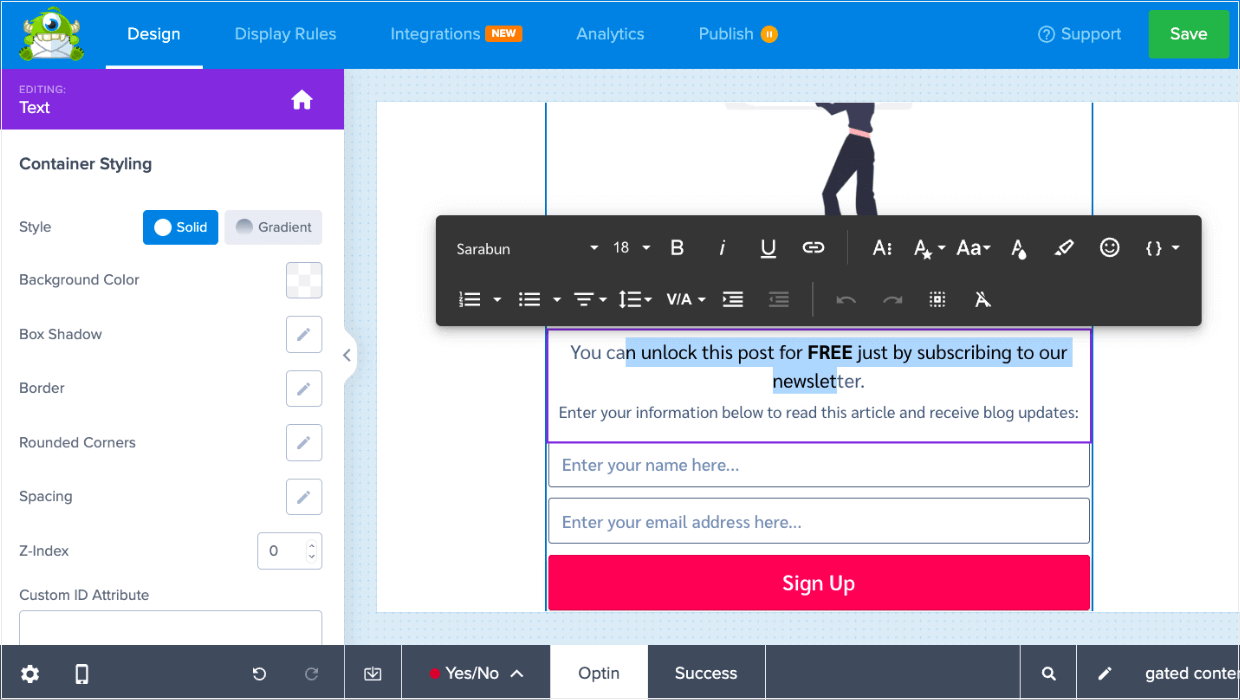
You can also change the images and button colors, or add or remove blocks.
Be sure to use the tabs at the bottom of the page to also edit the Success View. That’s the message users will see after signing up for your email list, informing them that the post will now be unlocked.
Step 4. Choose Your Display Rules and Publish Your Campaign
Next, go to Display Rules. Here, you’ll be able to precisely control who sees your gated content campaign and when.
Here we’ve set the optin to display when the content URL path exactly matches the URL of the page where we want the campaign to display. This allows you to choose which blog post you want to turn into gated content

More display rule options include:
- How long a user has been on a page
- How many pages the user has viewed on your website
- The geographic location of the user
- and much more
For more on OptinMonster’s Display Rules, check out our documentation:
How to Use Display Rules to Customize When a Campaign Will Appear
When you have everything set the way you want it save your campaign and choose the Publish tab at the top of the page. Change the Publish Status to Publish and follow any instructions based on your website platform.
Which Content Gating Tool Should You Use?
OptinMonster is the best content gating tool. It’s built-in content locking feature is proven to get results. Remember those stats I mentioned earlier?
- Marketing agency Whole Whale increased their email signups 100% with content gating
- Photography education site Photowebo saw a jaw-dropping 3806% lift in conversions by implementing gated content with OptinMonster
- Trading Strategy Guides added 11,000 subscribers using gated content in a little over a month
You can deliver your gated content immediately with OptinMonster’s success themes.
OptinMonster also integrates with all the major email marketing platforms and content management systems, so you can use it for gating content on any site.
Want to learn more about gated content before you get started? Here are a few helpful resources:
- Content Upgrades: How to Use Popular Posts for More Conversions
- How to Lock Content in WordPress for Premium Subscribers
- 7 Best Content Locker WordPress Plugins to Boost Your Conversions
- Ultimate Beginner’s Guide to Content Marketing
Once you’re ready to start skyrocketing your leads with gated content, sign up for OptinMonster! Choose the Plus plan or higher to access our Content Locking features.

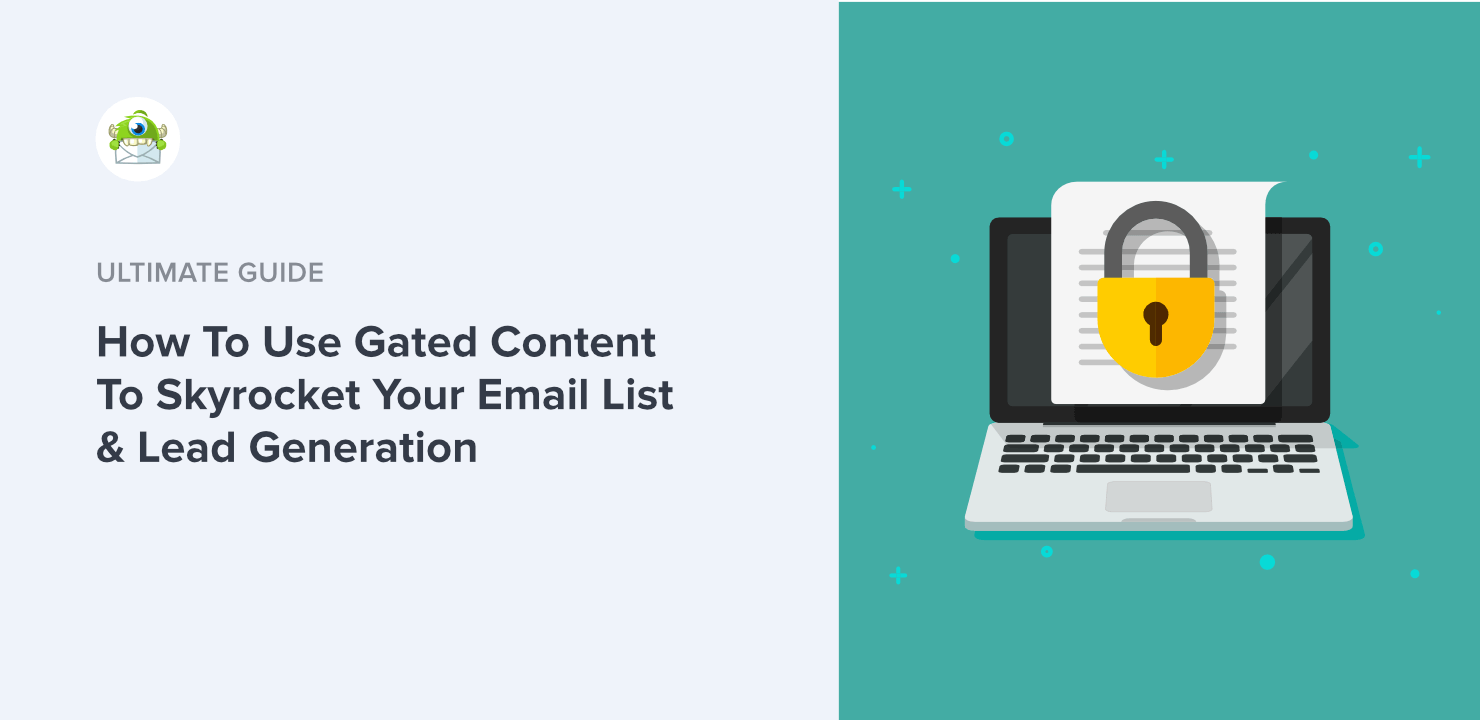
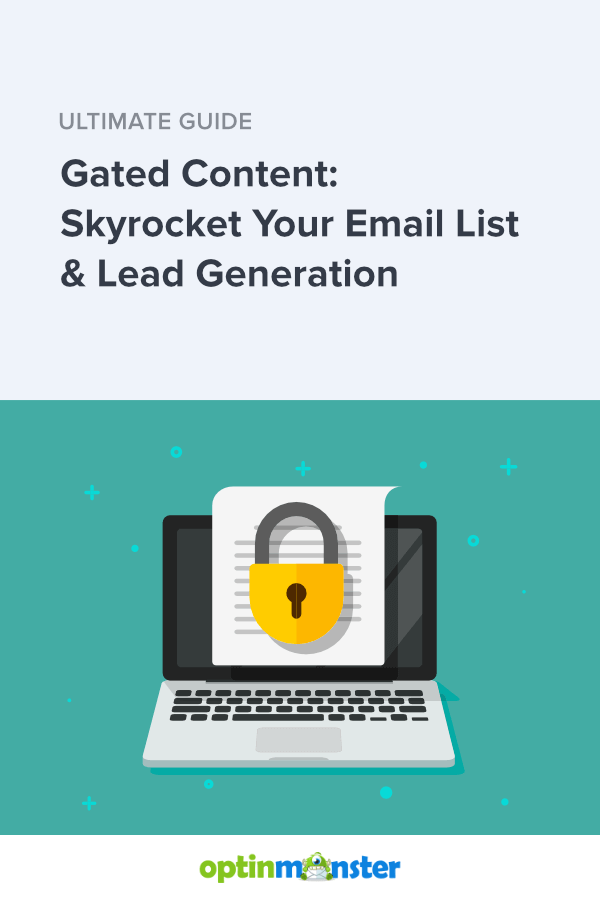








Add a Comment